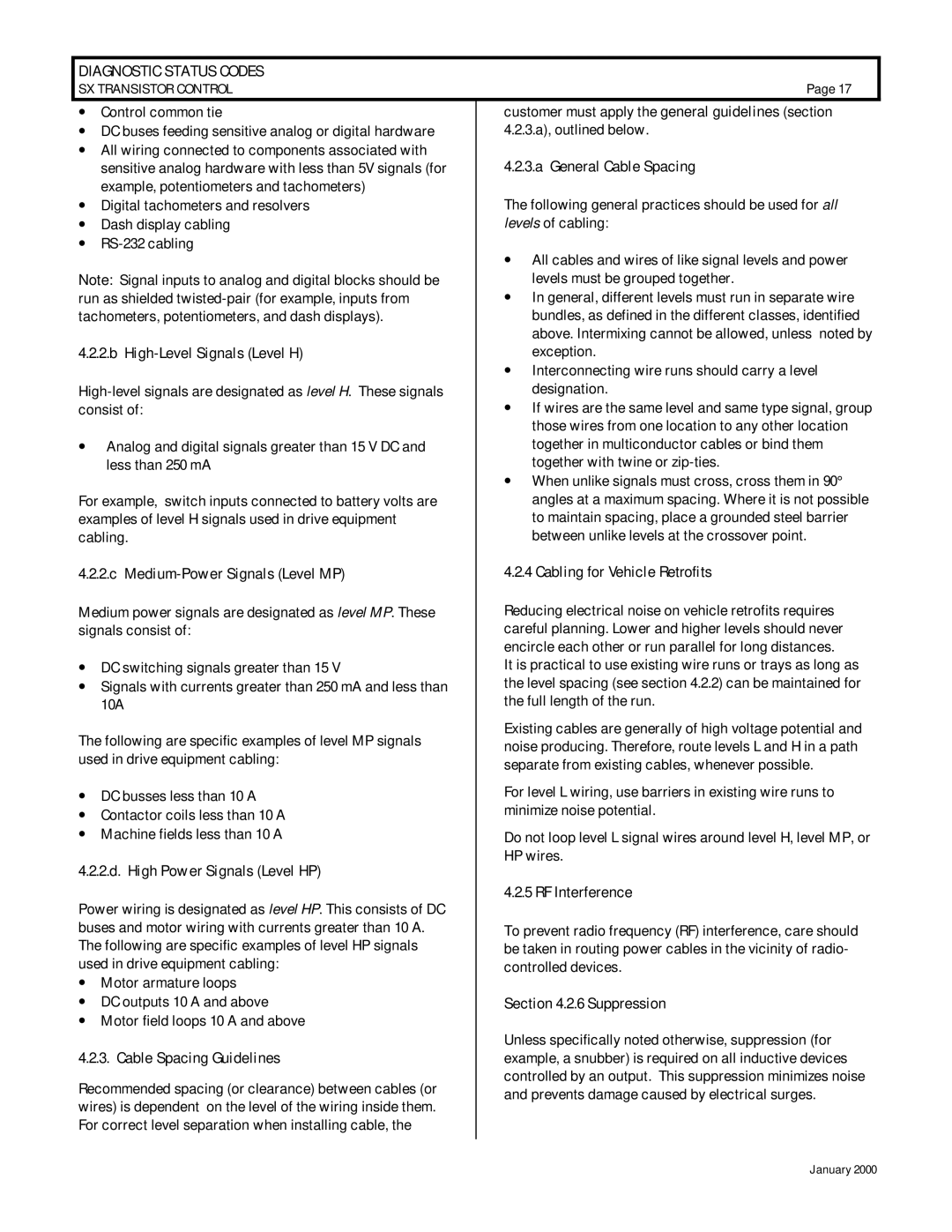
DIAGNOSTIC STATUS CODES
SX TRANSISTOR CONTROL | Page 17 |
•Control common tie
•DC buses feeding sensitive analog or digital hardware
•All wiring connected to components associated with sensitive analog hardware with less than 5V signals (for example, potentiometers and tachometers)
•Digital tachometers and resolvers
•Dash display cabling
•
Note: Signal inputs to analog and digital blocks should be run as shielded
4.2.2.b High-Level Signals (Level H)
•Analog and digital signals greater than 15 V DC and less than 250 mA
For example, switch inputs connected to battery volts are examples of level H signals used in drive equipment cabling.
4.2.2.c Medium-Power Signals (Level MP)
Medium power signals are designated as level MP. These signals consist of:
•DC switching signals greater than 15 V
•Signals with currents greater than 250 mA and less than 10A
The following are specific examples of level MP signals used in drive equipment cabling:
•DC busses less than 10 A
•Contactor coils less than 10 A
•Machine fields less than 10 A
4.2.2.d. High Power Signals (Level HP)
Power wiring is designated as level HP. This consists of DC buses and motor wiring with currents greater than 10 A. The following are specific examples of level HP signals used in drive equipment cabling:
•Motor armature loops
•DC outputs 10 A and above
•Motor field loops 10 A and above
4.2.3. Cable Spacing Guidelines
Recommended spacing (or clearance) between cables (or wires) is dependent on the level of the wiring inside them. For correct level separation when installing cable, the
customer must apply the general guidelines (section 4.2.3.a), outlined below.
4.2.3.a General Cable Spacing
The following general practices should be used for all levels of cabling:
•All cables and wires of like signal levels and power levels must be grouped together.
•In general, different levels must run in separate wire bundles, as defined in the different classes, identified above. Intermixing cannot be allowed, unless noted by exception.
•Interconnecting wire runs should carry a level designation.
•If wires are the same level and same type signal, group those wires from one location to any other location together in multiconductor cables or bind them together with twine or
•When unlike signals must cross, cross them in 90° angles at a maximum spacing. Where it is not possible to maintain spacing, place a grounded steel barrier between unlike levels at the crossover point.
4.2.4 Cabling for Vehicle Retrofits
Reducing electrical noise on vehicle retrofits requires careful planning. Lower and higher levels should never encircle each other or run parallel for long distances.
It is practical to use existing wire runs or trays as long as the level spacing (see section 4.2.2) can be maintained for the full length of the run.
Existing cables are generally of high voltage potential and noise producing. Therefore, route levels L and H in a path separate from existing cables, whenever possible.
For level L wiring, use barriers in existing wire runs to minimize noise potential.
Do not loop level L signal wires around level H, level MP, or HP wires.
4.2.5 RF Interference
To prevent radio frequency (RF) interference, care should be taken in routing power cables in the vicinity of radio- controlled devices.
Section 4.2.6 Suppression
Unless specifically noted otherwise, suppression (for example, a snubber) is required on all inductive devices controlled by an output. This suppression minimizes noise and prevents damage caused by electrical surges.
January 2000
